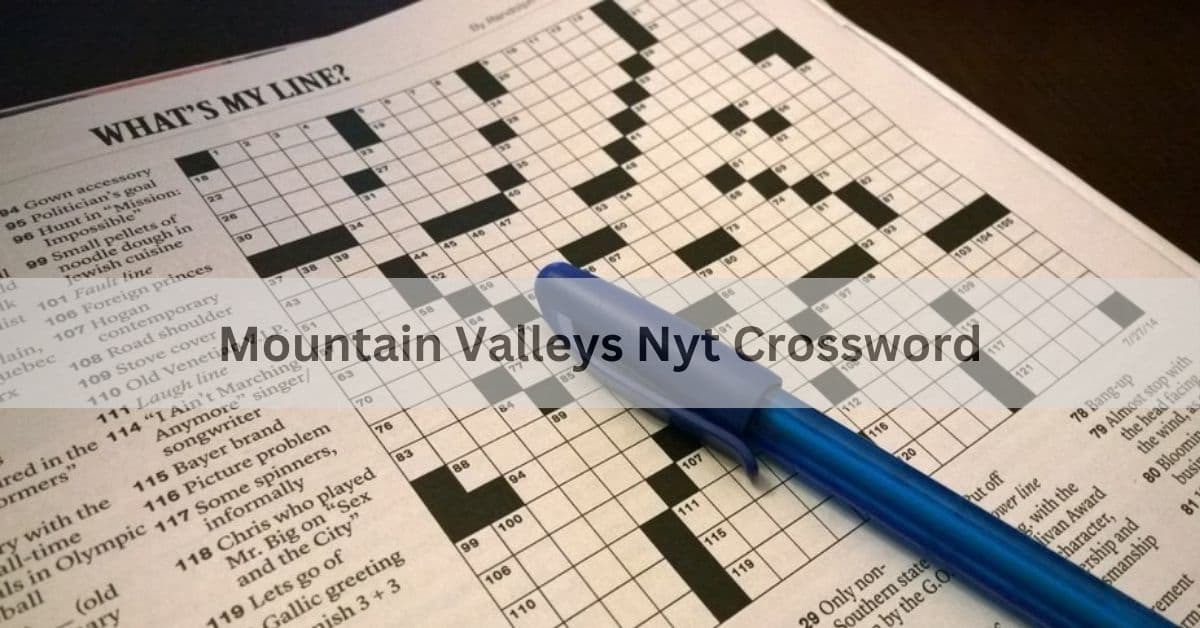Crossword puzzles have long captivated puzzle enthusiasts with their intricate clues and clever wordplay. One recurring theme in these puzzles involves geographical features, such as “mountain valleys.” If you’ve ever tackled a New York Times crossword and encountered the clue for “mountain valleys,” you might have been led to the answer “glens.” But what exactly are glens, and why are they such a compelling choice.
Table of Contents
What Are Glens?
At its core, a glen is a type of valley, specifically a narrow and often deep valley that is situated in a mountainous region. The term “glen” comes from the Scottish Gaelic word “gleann,” meaning a narrow, wooded valley. Glens are characterized by their distinctive features, including:

- Narrow Width: Unlike wide valleys, glens are relatively narrow, giving them a more intimate and secluded feel.
- Deep Terrain: Glens often have steep sides and a deep floor, which can create dramatic landscapes.
- Natural Beauty: Many glens are known for their picturesque scenery, often featuring lush vegetation, flowing streams, and tranquil settings.
The Geographic Charm of Glens:
The allure of glens lies in their natural beauty and unique geography. They are typically found in regions with significant elevation changes, such as:
- Scottish Highlands: Scotland is famous for its numerous glens, such as Glen Coe and Glenfinnan, which are celebrated for their stunning landscapes and historical significance.
- Appalachian Mountains: The eastern United States, particularly in areas like the Great Smoky Mountains, also features beautiful glens.
- Alpine Regions: Glens can be found in various mountainous regions around the world, including the Alps and the Rockies.
These regions are often associated with a sense of tranquility and isolation, making them ideal subjects for artistic and literary exploration.
Why Glens Appear in Crossword Puzzles?
Glens are a popular answer in crossword puzzles for several reasons:
- Conciseness: The word “glen” is short and fits well into crossword grids, making it a practical choice for puzzle creators.
- Distinctiveness: The term is specific enough to challenge solvers but familiar enough to be recognized, striking a balance that crossword constructors aim for.
- Cultural References: Glens are often featured in literature and folklore, adding a layer of cultural depth that can make crosswords more engaging.
Read Also: Yadontube – Revolutionizes Video Streaming With Advanced Features!
The Role of Glens in Literature and Culture:
Scottish Poetry and Glens
- Robert Burns: Renowned Scottish poet Robert Burns celebrated the natural beauty of glens in his works, reflecting the scenic and emotional significance of these landscapes. His poems often evoke the serenity and cultural heritage associated with glens.
- Sir Walter Scott: Another significant figure in Scottish literature, Sir Walter Scott, frequently referenced glens in his novels and poetry. His works, such as “The Lady of the Lake,” vividly describe the dramatic and picturesque aspects of Scottish glens.
Romantic Literature’s Fascination with Glens
- Nature as Symbol: During the Romantic period, poets and writers often used natural landscapes, including glens, as symbols of beauty, solitude, and introspection. Glens, with their secluded and serene characteristics, embodied the Romantic ideal of a return to nature and contemplation.
- Influence on Literature: The Romantic fascination with nature influenced various literary works, with glens serving as evocative settings that reflect characters’ emotional journeys and inner conflicts.
Music and Folk Songs Featuring Glens
- Traditional Scottish Folk Music: Glens are prominent in Scottish folk music, where they are often depicted as symbols of home, heritage, and natural beauty. Folk songs and ballads celebrate the landscapes and traditions of Scotland, with glens playing a central role in the narrative.
- Cultural Identity: The depiction of glens in music and folk songs reinforces their importance in Scottish cultural identity, representing a connection to the land and a sense of belonging.
Understanding Crossword Clues:
When tackling crossword clues related to “mountain valleys,” it’s essential to understand the various ways clues can be presented. Here are some common types of clues and strategies for solving them:
- Direct Clues: These clues provide a straightforward description, such as “mountain valleys” for “glens.”
- Cryptic Clues: In cryptic crosswords, clues might use wordplay or hidden meanings, requiring solvers to think outside the box. For example, “Narrow valleys” could hint at “glens” through wordplay.
- Thematic Clues: Sometimes, clues are part of a broader theme within the puzzle, which might give additional context to the answer.
Tips for Solving Crossword Clues:
To improve your crossword-solving skills, consider these tips:

- Learn Common Terms: Familiarize yourself with frequently used crossword answers and clues, such as “glen” for mountain valleys.
- Practice Regularly: The more you practice, the better you’ll become at recognizing patterns and solving clues.
- Use Crossword Dictionaries: Specialized dictionaries can provide insights into less common terms and phrases used in puzzles.
The Impact of Glens on Puzzle Design:
The use of glens in crossword puzzles reflects a broader trend of incorporating geographical and cultural elements into puzzle design. Puzzle creators often draw on various sources of inspiration, including:
- Geographical Features: Puzzles frequently include clues related to mountains, rivers, and other natural landmarks.
- Cultural References: References to historical events, famous locations, and cultural symbols enrich the puzzle experience.
- Wordplay and Trivia: Incorporating interesting facts and wordplay keeps puzzles engaging and intellectually stimulating.
FAQs:
1. What is the origin of the word “glen”?
The word “glen” originates from the Scottish Gaelic term “gleann,” which means a narrow valley. It reflects the term’s historical and cultural roots in Scotland.
2. Are there any famous glens outside of Scotland?
Yes, notable glens can be found worldwide, such as Glenwood Canyon in Colorado and Glen Etive in the Scottish Highlands, each with its unique landscape and natural beauty.
3. How do glens differ from canyons?
Glens are typically narrower and often found in mountainous regions with steep, wooded sides, while canyons are usually broader with more exposed rock formations and formed by erosion.
4. What role do glens play in local ecosystems?
Glens provide crucial habitats for diverse flora and fauna, offering sheltered environments with unique microclimates that support various species of plants and animals.
5. Can glens be popular hiking destinations?
Yes, glens often serve as popular hiking and trekking destinations due to their scenic beauty and challenging terrain, attracting outdoor enthusiasts seeking picturesque and tranquil settings.
Conclusion:
In conclusion, glens represent both the beauty of nature and a significant cultural symbol, frequently appearing in New York Times crosswords. Their distinctive, narrow valleys inspire literary and artistic works, adding depth to puzzle clues. These charming landscapes connect solvers to a rich tapestry of natural and cultural heritage.
Read Also:



